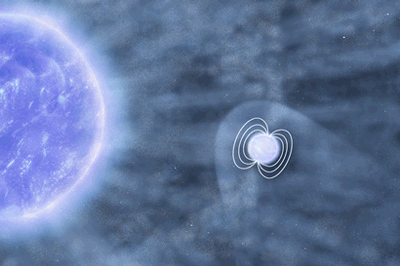Astronomers have observed an enormous X-ray outburst, probably caused by a star feeding on a giant clump of matter.
Neutron stars, forming after the death of massive stars, are so dense they generate extremely strong gravitational fields. The clump of matter came from a blue supergiant, orbited by a companion neutron star. It was much bigger than the compact star, which is only 10 km in diameter. Actually, it was so big that most of it did not hit the star.

During four hours, the flare was heated to millions of degrees by the gravitational field of the neutron star. If the neutron star had not been on its way, the flare would have disappeared into space without trace.
The flare was caught by ESA’s XMM-Newton, during a scheduled observation of the system, called IGR J18410-0535. It’s only when they received the data on Earth, 10 days later, that astronomers realised the X-ray observatory caught something special. Fortunately, the observation lasted long enough to see the flare from beginning to end.

Astronomers were able to estimate the size of the flare: it was about 16 million km across. That is 100 billion times the volume of our Moon! Although it was incredibly big, it was still much lighter than our satellite, about one thousandth of its mass.
Thanks to this incredible luck, astronomers will be able to better understand the behavior of the blue supergiant and the way it emits matter into space. Each and every star ejects matter into space, creating stellar wind: in this case, astronomers know that it seems to be emitted in a clumpy fashion.


